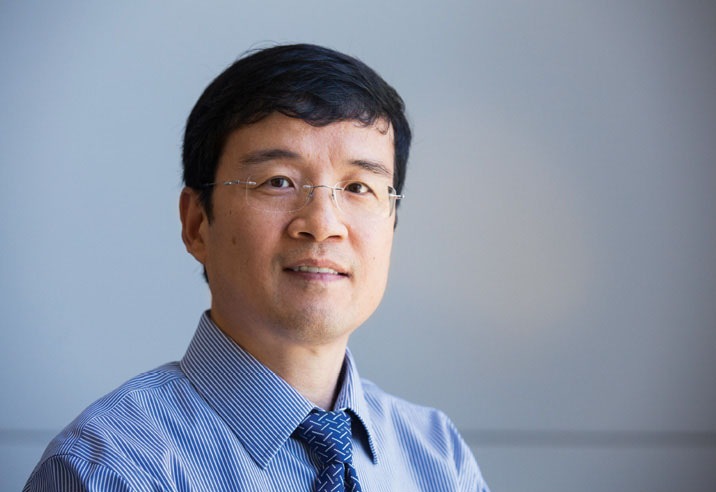
All in a day’s work
Allen Gao: Finding new tools against prostate cancer
As most late-stage prostate cancer patients know, androgens stimulate prostate cancer cells to grow.
If these hormones, which include testosterone, successfully bind to receptors on prostate cancer cell linings, they can prompt proliferation. Hormone therapy to lower androgen levels, coupled with therapies that shut down the receptors themselves, can shrink or slow the growth of prostate cancers.
There’s just one problem. Such therapies alone do not cure prostate cancer and, eventually, stop helping. That’s primarily because, sooner or later, the body finds alternative ways to get the androgen receptors working again.
That’s where the work of Allen Gao comes in. Gao, director of research in the UC Davis Department of Urology and the Ralph de Vere White Professor at the UC Davis Comprehensive Cancer Center, is dedicated to extending the lives of late-stage prostate cancer patients whose cancer has metastasized, typically despite the best of early care.
With success on a variety of fronts, Gao and his laboratory seek to better understand the molecular changes associated with the progression of prostate cancer cells, with an emphasis on the mechanisms of aberrant activation of androgen receptors. The goal: identification of diagnostic markers and therapeutic targets for patients who are running out of options to stop the progression of late-stage prostate cancer.
As Gao puts it, “We’re researching the reasons why androgen deprivation stops working, and we hope to use that research to develop new ways of making co-targets to improve hormone therapy effectiveness.”
His team’s latest research finding, published in the journal Clinical Cancer Research, demonstrates that niclosamide, a medicine commonly prescribed to fight tapeworms, dramatically enhances the efficacy of androgen-suppressing drugs such as enzalutamide.
As it turns out, some patients taking enzalutamide — often referred to as a second-generation treatment of last resort — develop a resistance to the drug due to the development of genetic variants that essentially re-activate their androgen receptors. Gao’s research in animal models showed that, when taken con-currently with enzalutamide, niclosamide successfully eroded proteins essential to a key genetic variant called AR-V7, thus staving off resistance to enzalutamide in subjects who have this variant. Furthermore, niclosamide inhibited prostate cancer cell growth and induced death of prostate cancer cells. Human trials are now in the works.
Growing up in the Sichuan province of China, best known as the home of the giant panda bear, Gao didn’t necessarily set out to become an expert in this relatively arcane field. After earning his medical degree from the Sichuan University West China Medical Center, he went on to pursue a Ph.D. in molecular biology at the University of Texas M.D. Anderson Cancer Center, followed by a postdoctoral fellowship at Johns Hopkins University in Baltimore.
Narrowing his research focus to the molecular mechanisms of late-stage prostate cancer, he went on to serve as an assistant professor at the University of Pittsburgh and professor at the Roswell Park Cancer Institute at SUNY at Buffalo. In 2007, he relocated to UC Davis, where he also co-leads the Prostate Cancer Program at the cancer center.
Today, he oversees the center’s urological research lab, whose staff of postdoctoral fellows, graduate students, and researchers is funded by major grants from the National Institutes of Health, Department of Defense, and Veterans Administration, augmented by the center’s own endowment program. Rounding out the staff are several young volunteers seeking to broaden their training in this field.
As evidenced by his work on niclosamide, Gao’s research increasingly blends genetics with biology as he simultaneously explores both the genetic and molecular pathways that lead cancer-related genes to turn on and off. DNA sequencing — the process of determining the precise order of nucleotides (organic molecules that play central roles in metabolism) within a DNA molecule — is an important tool for Gao and his team as they seek to understand the alterations that occur during late-stage prostate cancer progression.
Last year, the group published a paper in the journal Molecular Cancer Therapeutics pinpointing overexpression (over-production) of a protein called p52 in prostate cancer cells, leading to the promotion of cell growth and the aberrant activation of androgen receptors. In turn, these cells become resistant to enzalutamide.
In a paper published early this year in the journal Endocrine-Related Cancer, Gao and his team built on the findings, using analysis of DNA arrays to show that these p52-overexpressing cells also overexpress glucose, a form of sugar. Since these cells apparently depend on this extra glucose and are sensitive to its deprivation, their growth can potentially be stopped through the deprivation of glucose, which in turn could re-sensitize prostate cancer cells to enzalutamide treatment. This suggests a potential therapeutic approach for late-stage prostate cancer patients experiencing resistance to enzalutamide.
A paper that Gao and his group published early this year in the journal The Prostate identified a different potential therapeutic approach. They had earlier established that expression of a cytokine (a category of small proteins important in cell signaling) called Interleukin 6 in prostate cancer cells can cause resistance to enzalutamide. In this paper, they found that Interleukin 6 activates a protein called Stat3 and, most importantly, that application of a Stat3 inhibitor reversed enzalutamide resistance in prostate cancer cells.
“The current therapy for late-stage prostate cancer patients provides some improved care and extension of life, but eventually resistant mechanisms will occur,” says Gao. “There’s reason for hope, however, because researchers around the world are exploring new drugs and other therapeutic interventions to improve survival.”
He adds, “At the UC Davis Comprehensive Cancer Center, we have a state-of-the-art laboratory and a cross-disciplinary team of clinicians and researchers dedicated to improving therapies and patient care. I am optimistic that, in the foreseeable future, we can not only identify but also move into clinical practice a variety of effective tools to further extend the lives of late-stage prostate cancer patients.”
